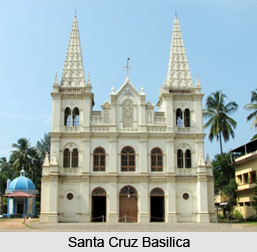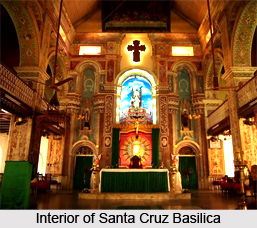 Santa Cruz Basilica at Fort Kochi is one of the eight Basilicas in India. Counted as one of the heritage edifices of Kerala, this church is one of the finest and most impressive churches in India and visited by tourists the whole year round. It is a place of devotion as well as a center of historic significance, endowed with architectural and artistic grandeur and colours of the gothic style. Located close to the renowned St. Francis Church, this basilica serves as the cathedral church of the Diocese of Cochin, the second oldest Diocese of India.
Santa Cruz Basilica at Fort Kochi is one of the eight Basilicas in India. Counted as one of the heritage edifices of Kerala, this church is one of the finest and most impressive churches in India and visited by tourists the whole year round. It is a place of devotion as well as a center of historic significance, endowed with architectural and artistic grandeur and colours of the gothic style. Located close to the renowned St. Francis Church, this basilica serves as the cathedral church of the Diocese of Cochin, the second oldest Diocese of India.
It was built originally by the Portuguese and elevated to a Cathedral by Pope Paul IV in 1558, was spared by the Dutch conquerors who destroyed many Catholic buildings. Later the British demolished the structure and Bishop D. Joao Gomes Ferreira commissioned a new building in 1887. Consecrated in 1905, Santa Cruz was proclaimed a Basilica by Pope John Paul II in 1984.
History of Santa Cruz Basilica
The history of Santa Cruz Basilica dates back to the 16th century and begins with the arrival of Portuguese missionaries in 1500 CE. The construction works started when the first Portuguese Viceroy Dom Francisco de Almeida got permission from the Cochin Raja to build a church. The foundation stone was laid on May 3, 1505, the feast day of the "Invention of the Holy Cross"; hence the church was named "Santa Cruz". Meanwhile the church had undergone some serious demolition and re-erection. The present day structure was consecrated on 19th November 1905. In 1984 Pope John Paul II raised the status of Santa Cruz Cathedral to Basilica for its antiquity, artistic dignity and historical importance.
Architecture of Santa Cruz Basilica
The Basilica has magnificent Indo-European and Gothic architecture and the grandeur in the use of colours. The church has two lofty spires and a remarkably bright, white-washed exterior and a pastel-colored interior. The interiors of the church are mostly Gothic style architecture, with the main altar decorated by the famous Italian painter Fr Antonio Moscheni and his disciple De Gama of Mangalore. The columns decorated with frescoes and murals, the 7 large canvas paintings on the passion and death on the Cross, especially the painting of the "Last Supper", modelled on the famous painting of Leonardo Da Vinci and the beautiful stained glass windows add to the artistic grandeur of the place. The paintings that adorn the ceiling depict scenes from the "Via Crucis of Christ".
Visiting information to Santa Cruz Basilica
One can access Fort Kochi by bus or boat from Ernakulam. The nearest railway station is Ernakulam Railway Station about 12 km away and the nearest airport is Cochin International Airport, about 45 km.





















